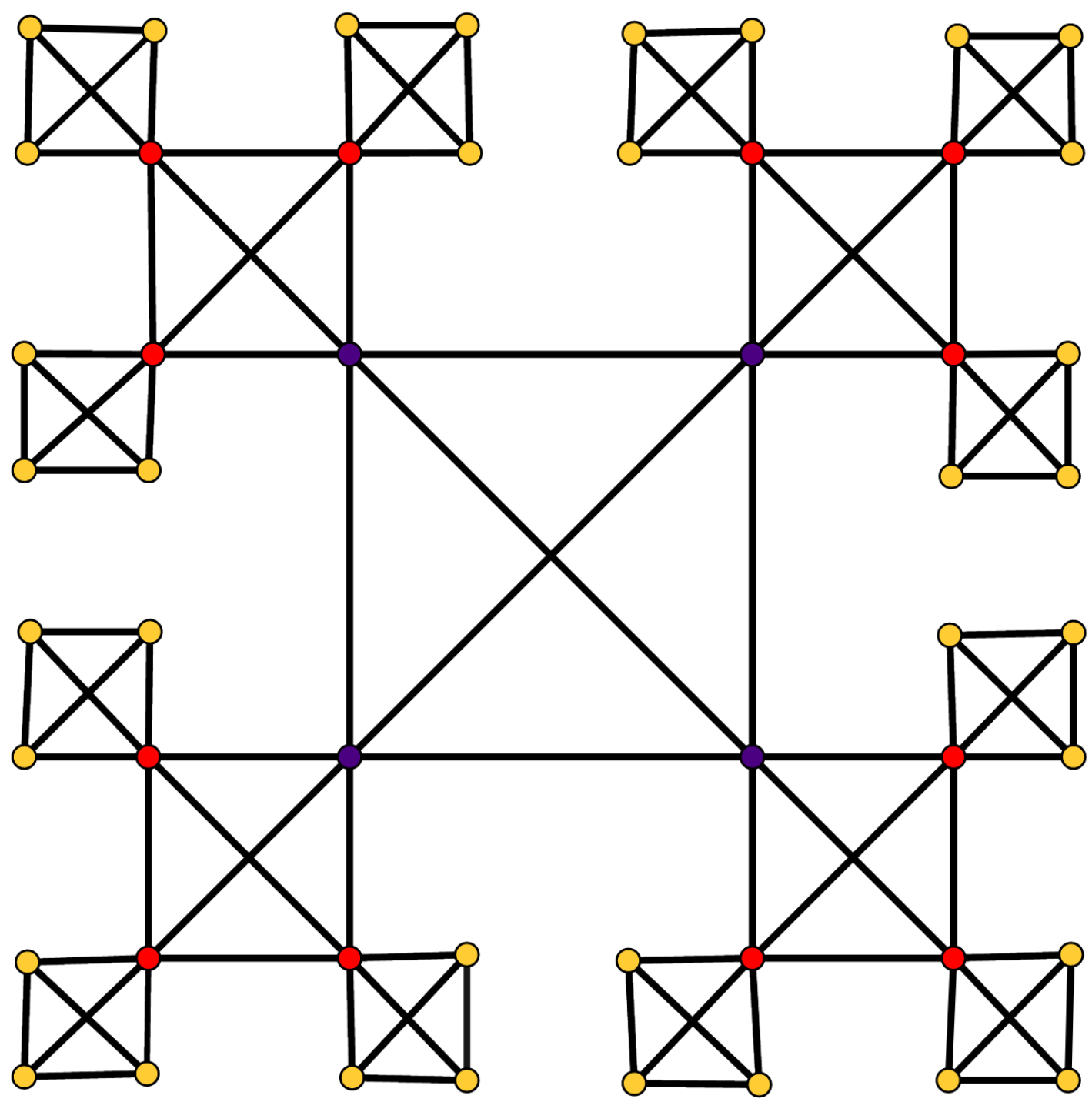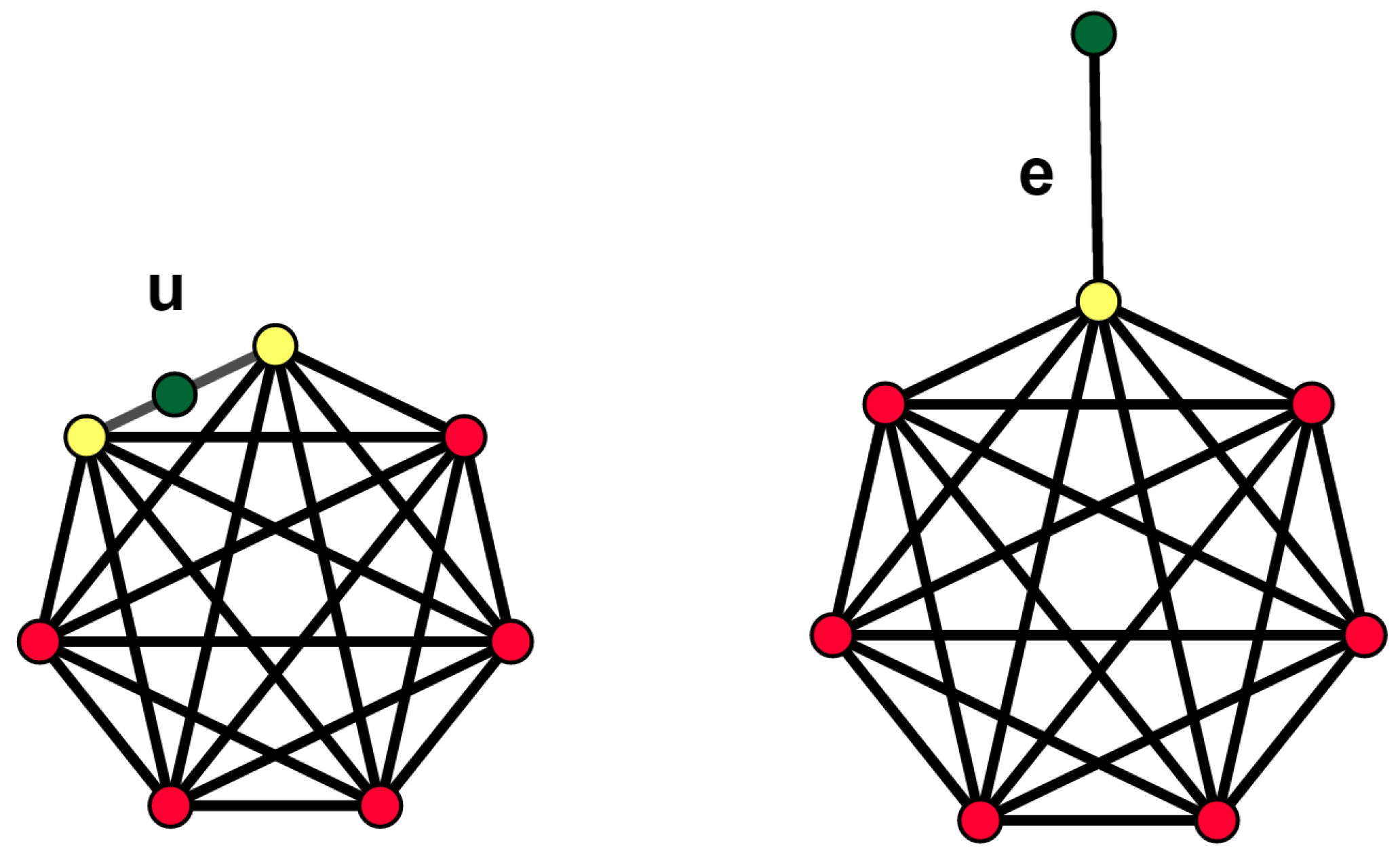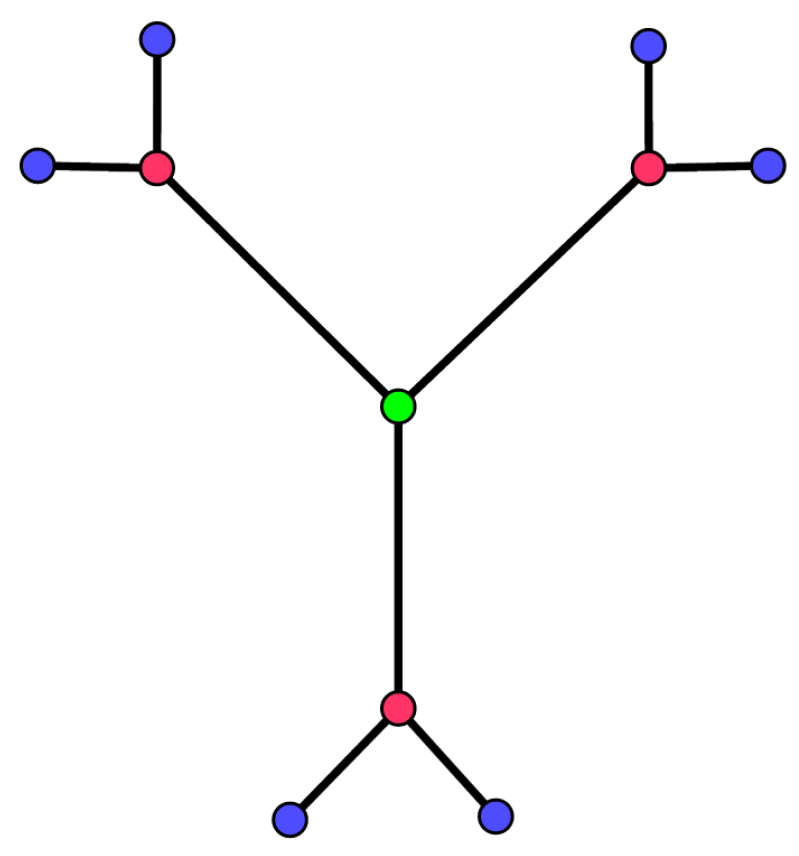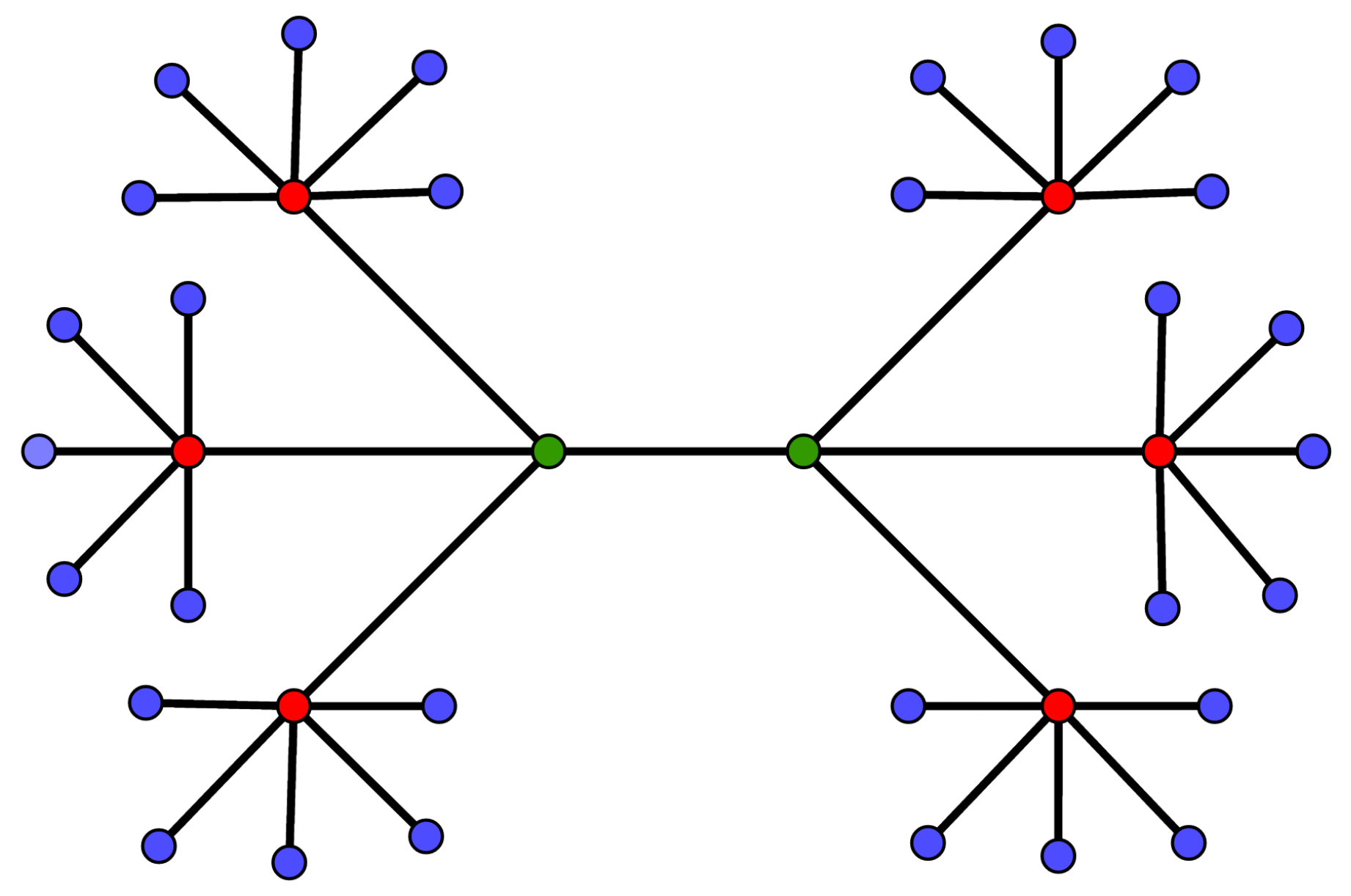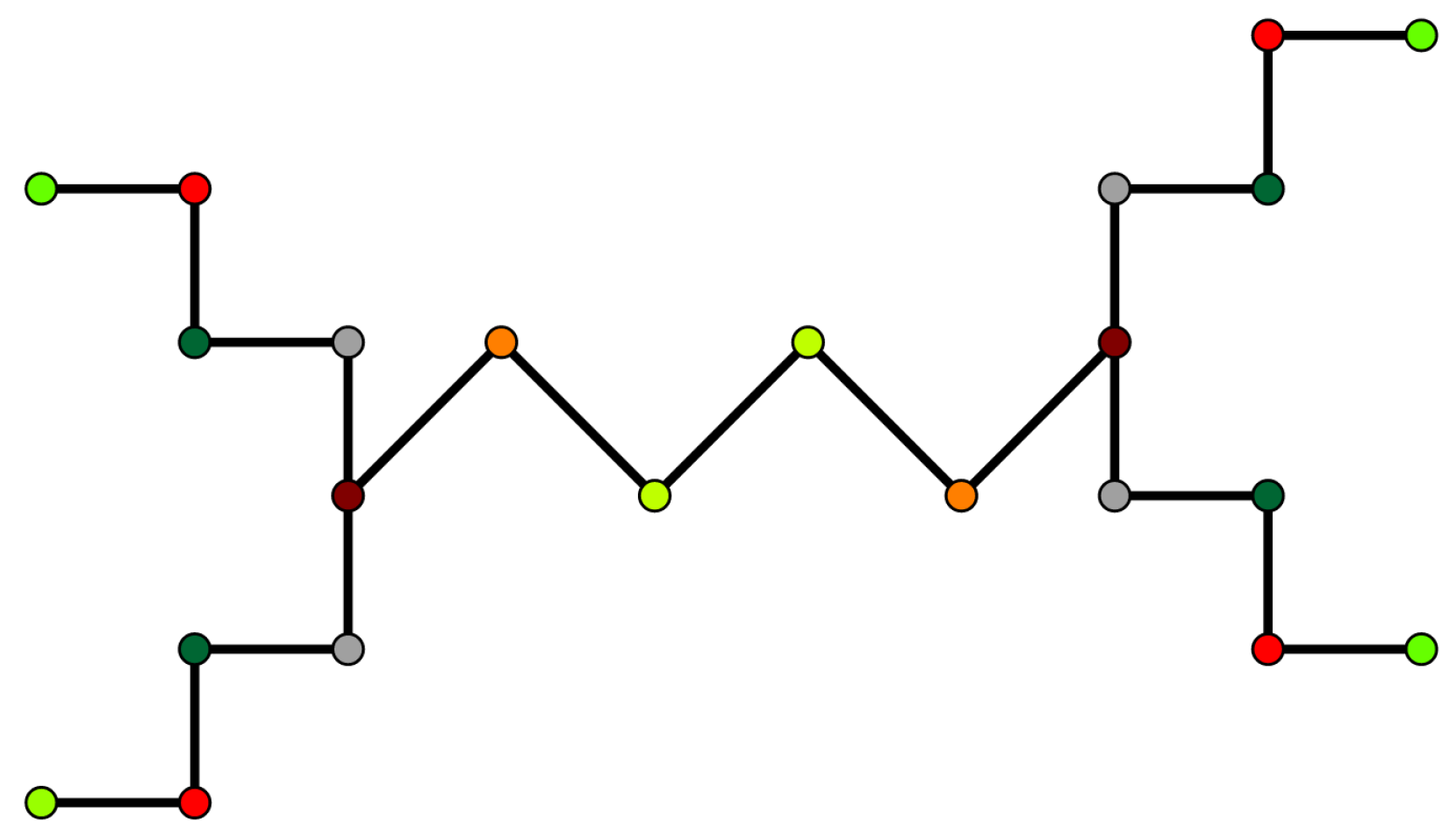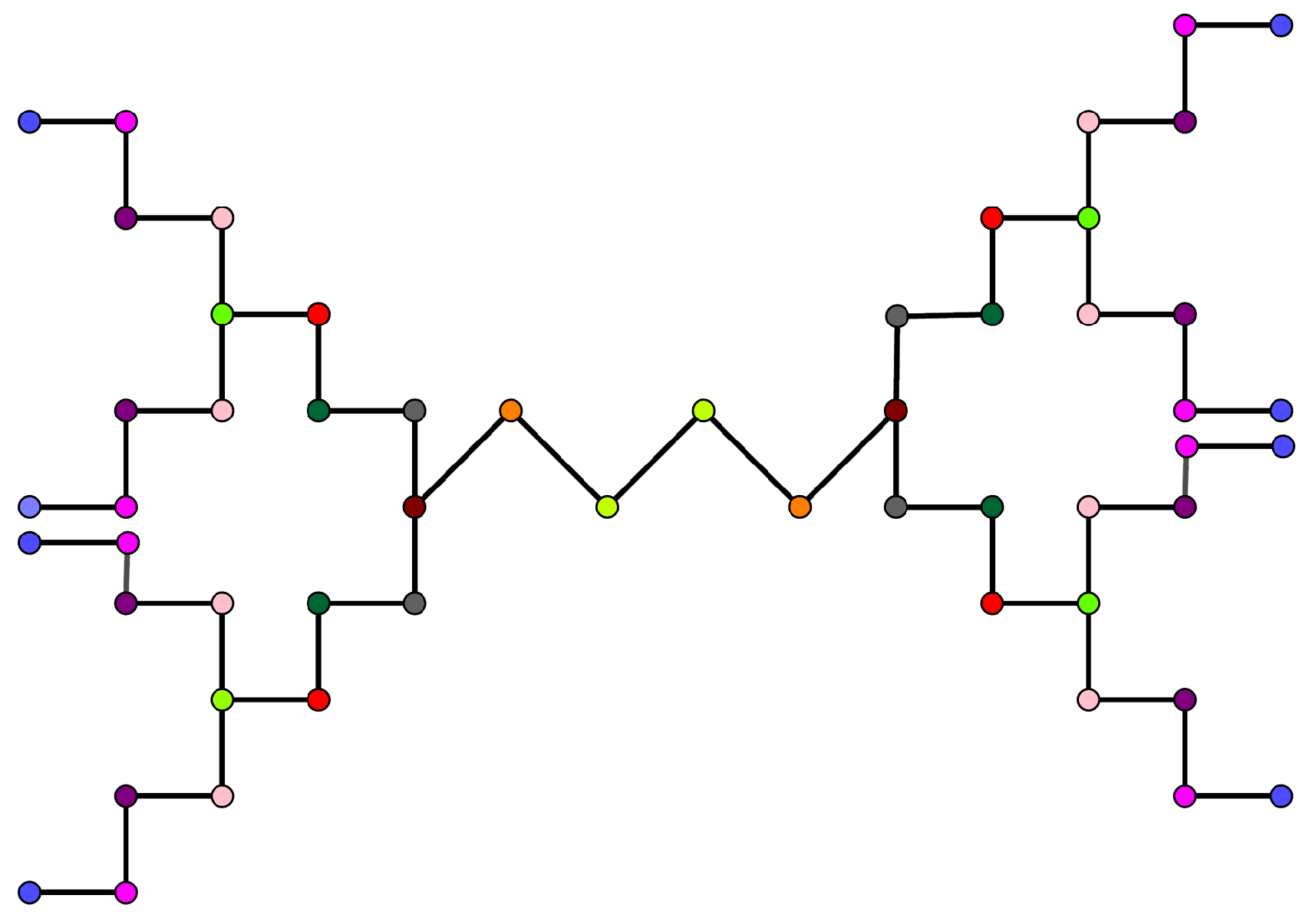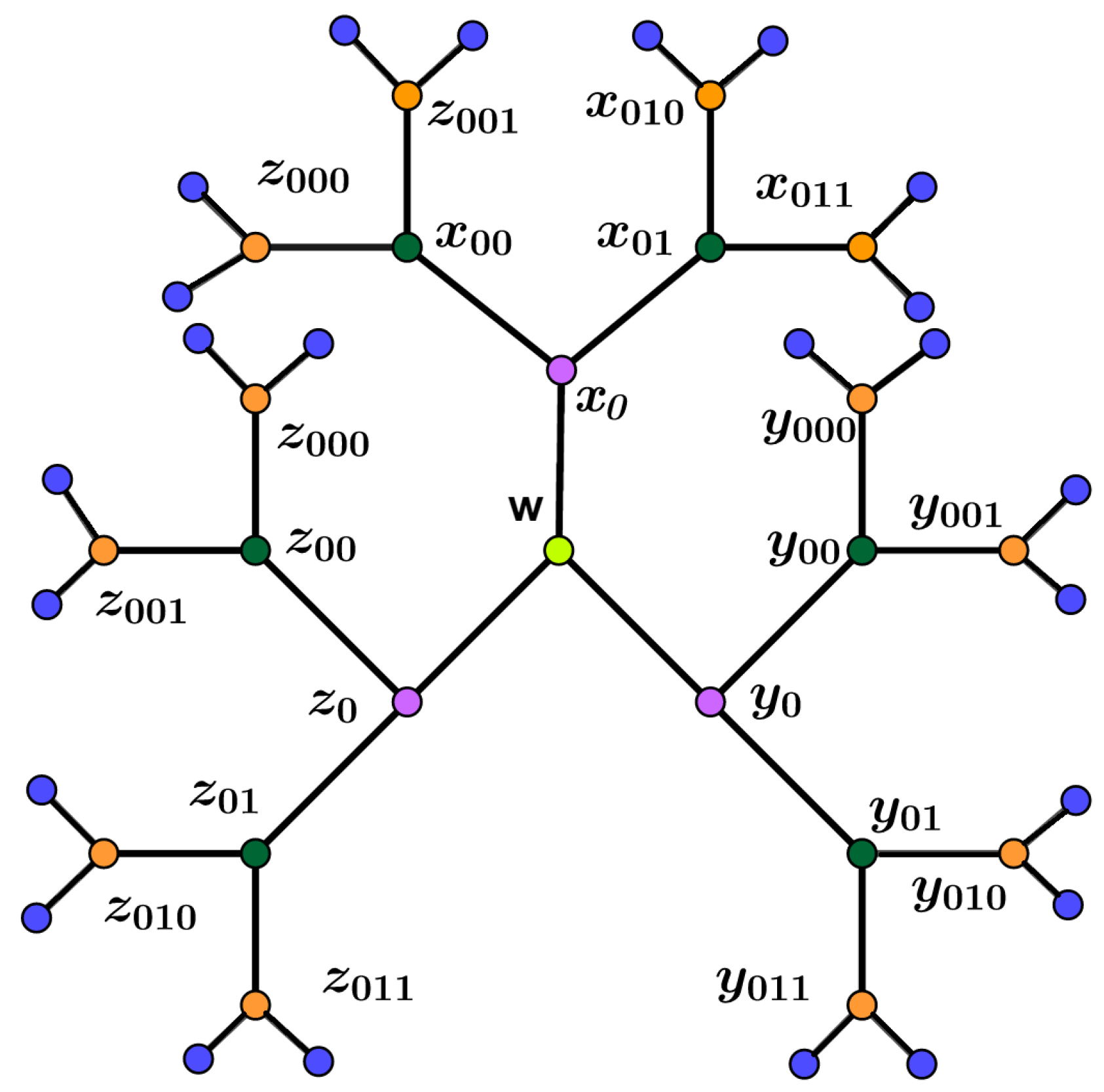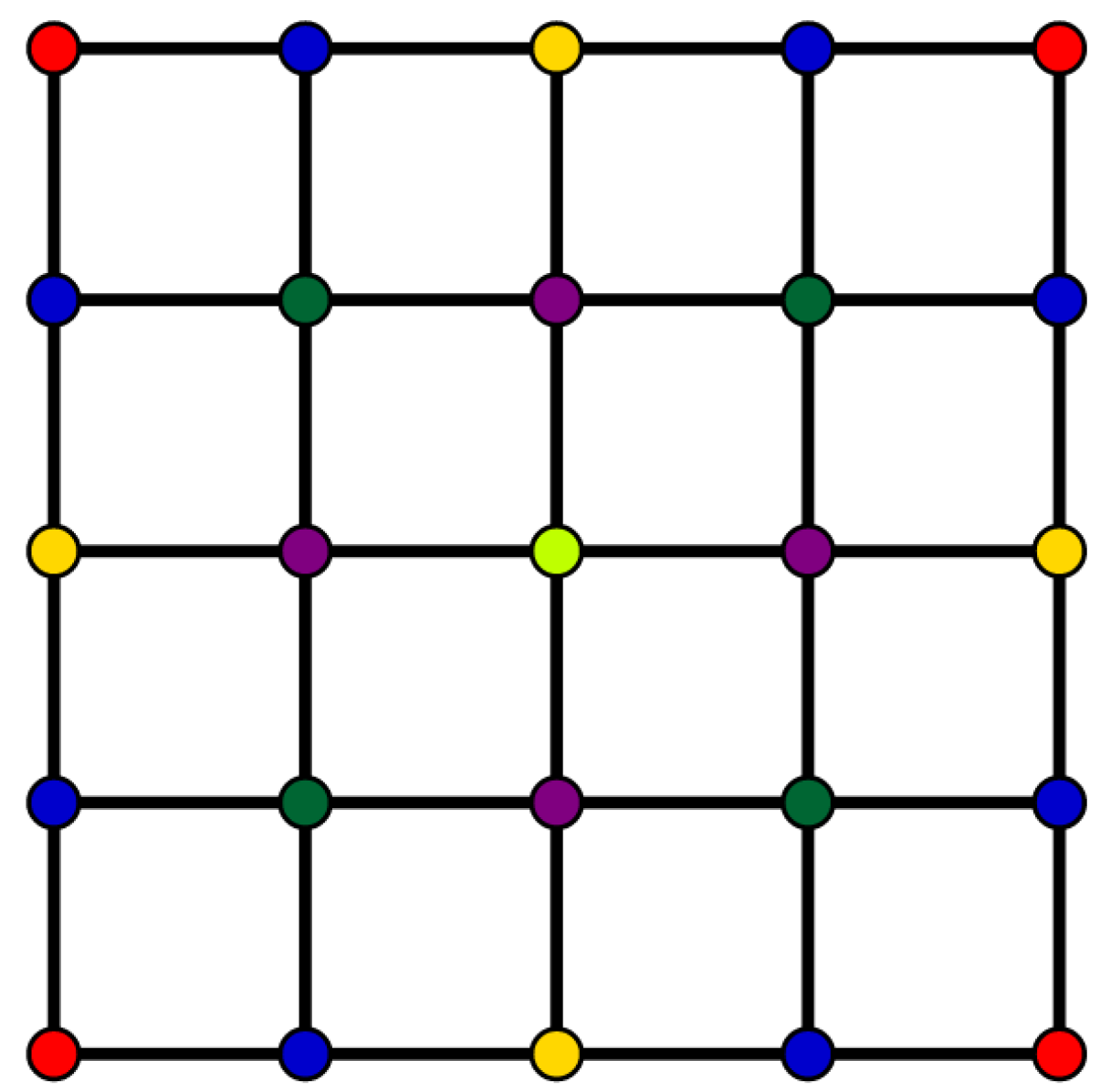For example consider the cycle graph
in
Figure 1. The line of symmetry colored by red is denoted by permutation
. Hence, the permutations correspond to blue and green lines are respectively denoted by
and
. A clockwise rotation equal
around the middle point of
is denoted by
and equal
by
. All of these permutations preserve the vertex adjacency and thus are automorphisms. Note that a
rotation preserves the figure unchanged and we denote this permutation by
. Hence, the automorphism group of
has 6 elements which is
.
The orbits of the automorphism group of a graph form a partition of the vertices of the graph. This decomposition introduces the symmetry structure of the graph, and the orbit entropy measure obtained from the automorphism group provides an index of the complexity of the graph relative to the symmetry structure.
2.1. Relationship between Symmetry Index and Orbit Entropy
Consider a permutation on the set . Then the set of all elements that moves is called the support of . Two permutations and are disjoint if their supports have no intersection. Consider S to be a set of generators of , and to be the partition of S, where cannot be decomposed into smaller support-disjoint subsets. Therefore, we have the following.
Theorem 1. Ref. [20] If , then . Consider . For a vertex v in , denotes the stabilizer subgroup of G containing all automorphisms that fix the vertex v. Similarly, for a vertex u of G, its orbit is a set containing all , where is an automorphism of .
Theorem 2. Ref. [21] (Orbit-stabilizer Theorem) Let A be a permutation group acting on a set Ω and u be an arbitrary point in the set Ω. Then . Definition 1. Harary [22] defined the corona product of two graphs and as a new graph G obtained by taking one copy of (which has vertices) together with copies of and then joining the ith vertex of to all vertices in the ith copy of ; see Figure 2. Suppose
A and
B are two finite groups in which
B acts on the set
X. The wreath product of
A and
B (denoted by
) is a group with the underline set
The group operation can be defined as
, where for each element
, we obtain
Wreath product is one of the most significant combinatorial buildings in the field of permutation group theory. The next theorem shows that the automorphism group of a big graph can be constructed from wreath product of automorphism groups of its subgraphs.
Theorem 3. Ref. [22] The automorphism group of the corona product of two graphs is isomorphic to the wreath product if and only if either or has no isolated vertices. Let
G and
H be two disjoint graphs, where
, and let
and
. The splice of two graphs
G and
H by vertices
u and
v, denoted by
, is a new graph constructed by identifying two vertices
u and
v in the union of
G and
H [
23]. Similarly, let
K be a graph constructed by
G and
n copies of graph
H and then splicing vertex
of
G by vertex
v of the
ith copy of
H. The following result is contained in [
24,
25,
26,
27,
28].
Theorem 4. (Balasubramanian) Let K be as defined above. Then .
Here, the orbit-entropy measure and the symmetry index of some classes of well-known graphs are determined, followed by a comparison of these measures for all the graphs. The results show that whether a measure is greater or smaller cannot be predicted in advance, and it depends on the structure of the graph or equivalently the structure of its automorphism group.
Example 1. It is demonstrated that the orbit entropy of the path graph is greater than its symmetry index, whereas for the wheel graph , the star graph , and the complete bipartite graph , the orbit entropy is less than the symmetry index. To do this, consider the following cases:
- (a)
If n is odd, then and has orbits of size two and a singleton orbit. Hence, and . This means that if , then .
- (b)
If n is even, then and G has orbits of order 2. Hence, and .
- (c)
If , then and G has a singleton orbit together with an orbit of size . Thus,and - (d)
For the wheel graph , it is well known that , and consequently it has a singleton orbit and an orbit of size . Hence, - (e)
If , then , and consequently G has two orbits of sizes m and n. Thus,and
This completes the proof.
Theorem 5. Let G be a graph with an automorphism group containing the identity element alone. Then .
Proof. Assume that
G is a graph on
n vertices and
. Hence,
G has
n orbits, giving
and
. □
If the automorphism group of G acts transitively on , then it is concluded that G is vertex-transitive. Equivalently, a vertex-transitive graph has only one orbit. Similarly, an edge-transitive graph can be defined.
Theorem 6. If G is vertex-transitive, then .
Proof. Because G has only one orbit, and . Therefore, . □
The Cayley graph is a graph constructed from a group A and a subset , where and . The vertex set of graph G comprises the elements of A, and two vertices a and b are adjacent if and only if .
Corollary 1. If G is a Cayley graph or , then the symmetry index of G is greater than its orbit-entropy measure.
Proof. It is well known that each Cayley graph is vertex-transitive [
29], and the assertion follows. On the other hand, it is well known that
, where
denotes the dihedral group of order
with the following presentation:
Also, , which implies that both and are vertex-transitive, and we are done. □
Two vertices u and v of a graph G are said to be similar if there is an automorphism such that . Herein, all similar vertices have the same color.
Corollary 2. For the MacPherson graph as shown in Figure 3, and . Proof. It is obvious that
G is constructed by
and
n copies of graph
and then by splicing each vertex
of
by vertex
u of the
ith copy of
. This means that
. In [
30], it is proved that
G is vertex-transitive. Considering this fact and Theorem 6, we may conclude the assertion. □
Theorem 7. If G is a regular edge-transitive graph, then .
Proof. Note first that if G is vertex-transitive, then from Theorem 6. Thus, we can assume that G is not vertex-transitive. Therefore, it is bipartite, and because G is regular, two independent sets are exactly the orbits of on . This means that , and by Example 1, the required result is obtained. □
Theorem 8. Let G be a graph of order , with singleton orbits and an orbit of order two. Then , and for , we have . In addition, if G has singleton orbits and an orbit of order three, then .
Proof. Suppose that and G has an orbit of size two. Then and thus . If , then and so , and . If , then . If , then and . This gives , and the assertion follows. If G has singleton orbits and an orbit of order three, then or . If , then and . One can see that for , and thus . If , then and . Thus we have for . □
Theorem 9. Consider G to be a graph of order n, with singleton orbits and an orbit of order k. Consider the size of the automorphism group to be less than or equal to . Then .
Proof. The following arise by definition:
Therefore, if , then . □
Theorem 10. Assume that G is a graph on n vertices and that the orbits of are of equal size. Thus for , we have , where v is an arbitrary vertex in and .
Proof. Suppose that G has k orbits. Then and , where m is the orbit size. Thus, if and only if if and only if . For a given automorphism of graph G, the fix point of is defined by . □
Theorem 11. Let G be a graph on n vertices and . If , then .
Proof. Suppose that
are all orbits of
A. Because
, we obtain
, thus
. Hence,
. From the Burnside Lemma [
21], the number of orbits is
. This yields
. Now if
, then
. Thus,
and so
This leads to . □
Theorem 12. Suppose that and ; see Figure 4. Then and . Proof. Clearly,
has
n vertices of degree
and a vertex of degree two. This leads to
. Hence
has three orbits of sizes one, two, and
, respectively, which means that
Meanwhile,
has
vertices of degree
, a vertex of degree
n, and a vertex of degree one. This together with the fact that
leads us to assume that
has three orbits of sizes one, one, and
, respectively, and therefore
This completes the proof. □
A caterpillar tree is a tree in which all the vertices are within distance one of a central path. In other words, the caterpillar tree
consists of a path with
r vertices in which
pendent edges are attached to the
ith vertex of
; see
Figure 5.
Theorem 13. Let be a caterpillar tree, where . Then .
Proof. The graph
G has
vertices, and from Theorem 1 we have that
. This leads to the conclusion that
G has
orbits, and thus
and
Hence, . □
Theorem 14. If T is a tree with two orbits, then .
Proof. Let
T be a tree with two orbits. It is well known that
or
[
22]; see
Figure 6. If
, then
, and thus
. Meanwhile,
. Hence,
. If
, then from Example 1 we obtain
. □
Theorem 15. If T is a tree with three orbits, then .
Proof. It is well known that each tree has either a central vertex or a central edge [
31]. First, suppose that
T has a central vertex. The central vertex gives rise to a singleton orbit, and the leaf vertices are in the second orbit. If the leaf vertices give rise to at least two orbits, then
T has at least four orbits, which is a contradiction. Hence, the leaf vertices necessarily lie in the same orbit. The other vertices are in the same orbit, therefore they all have the same degree. On the other hand, the leaf vertices are adjacent to the central vertex because there are only three orbits. This leads us to investigate
; see
Figure 7. Clearly,
T has
vertices, and Theorem 4 gives
, where the sizes of the orbits of
T are one,
n, and
, respectively. This means that
Assume that
T has a central edge. By a similar argument, it can be proved that
T is isomorphic with graph
, as shown in
Figure 8. Theorem 4 gives
, and thus
T has three orbits of sizes two,
, and
, respectively. Therefore, we have that
This completes the proof. □
2.2. Orbit Entropy and Symmetry Index of Dendrimers
A dendrimer is a molecular graph associated with a dendrimer molecule. In this section, we determine the entropy or information content of some dendrimers. In the case of organic molecules, the lower the information content (or the greater the symmetry), the fewer the possibilities for different interactions with other molecules. If all the atoms are in the same equivalence classes, then it makes no difference which one interacts with an atom of another molecule.
Theorem 16. For the dendrimer shown in Figure 9, we obtain . Proof. The fact that
can be verified from
Figure 9 and
Figure 10. It is not difficult to prove that
. Using induction on
n yields
, where “:” denotes the semi-direct product [
22]. It is clear that
has three orbits of size two and four orbits of size
,
. Hence, the symmetry index and the orbit-entropy measure of dendrimer
are given by
□
Here, we study the orbit-entropy measure and the symmetry index of another class of dendrimers, namely
, shown in
Figure 11. For a given vertex
, suppose that
and
X is a subset of vertices of graph
G. By
, we mean the induced subgraph of
G with vertex set
X, and two vertices in
X are adjacent if and only if they are adjacent in
G. The central vertex
t has degree three and
. There are three branches rooted at vertices
,
, and
. For two vertices
, the distance between them is the length of the shortest path connecting them, denoted by
. By the
ith level of
, we mean the set of vertices at distance
i from the central vertex
w.
Theorem 17. For the dendrimer graph , we have .
Proof. It is obvious that . Similarly, , and if , then we have from the structure of . Now, using induction on n shows that .
Hence,
has
orbits as follows.
is a singleton set containing the central vertex
w. For
, the
ith orbit contains all vertices at distance
i from the central vertex. Hence, the vertices of the
kth level of this graph are the vertices of the form
,
, or
of length
k, where
. Therefore, we have that
□
Consider the lattice graph
that is the Cartesian product of two graphs
and
, see
Figure 12. Thus, we have the following.
Theorem 18. Let . If , then we have for . If , then we have for .
Proof. Consider . Thus, G has vertices and , and the following two cases hold.
- (a)
If n is odd, then G has orbits of size four and orbits of size eight. Thus, and . For , we obtain , thus .
- (b)
If n is even, then G has n orbits of size four, orbits of size eight, and a singleton orbit. Hence, and . For , , and thus .
Consider . Thus, , and the following four cases hold.
- (a)
If m and n are odd, then G has orbits of size four. Thus, and . Therefore, if , then .
- (b)
If m is even and n is odd, then G has orbits of size four and orbits of size two. Thus, and . Therefore, if , then .
- (c)
If m is odd and n is even, then G has orbits of size four and orbits of size two. Thus, and . For , we obtain .
- (d)
If
m and
n are both even, then
G has
orbits of size four,
orbits of size two, and one singleton orbit. Thus,
and
Therefore, if , then .
□


